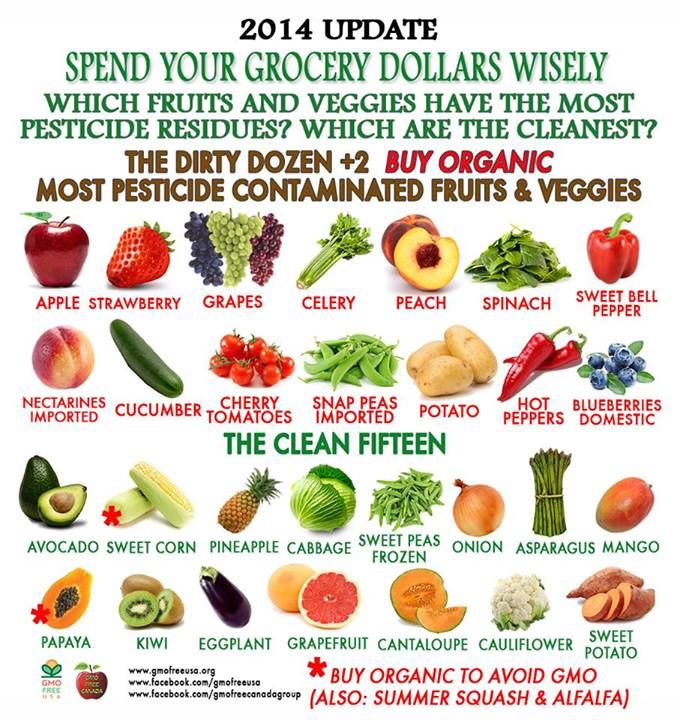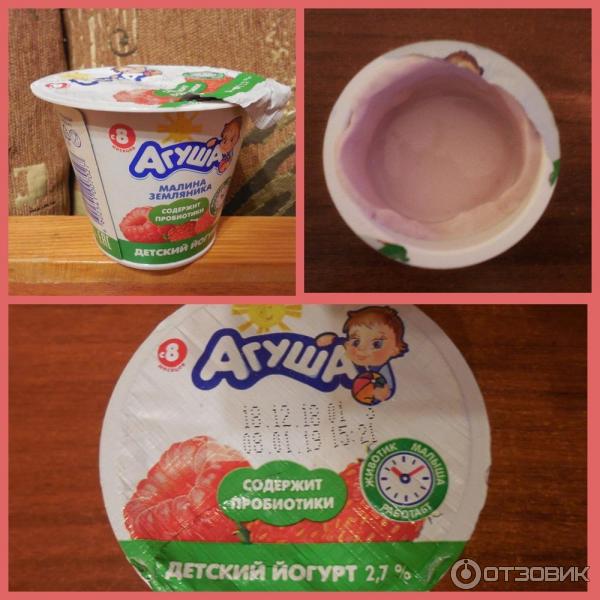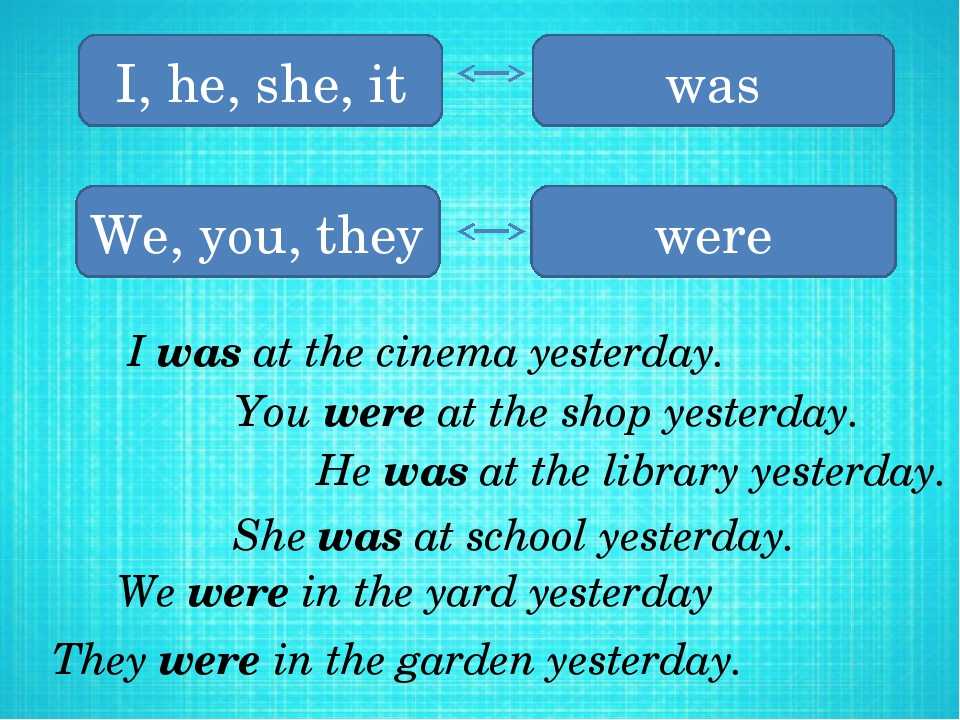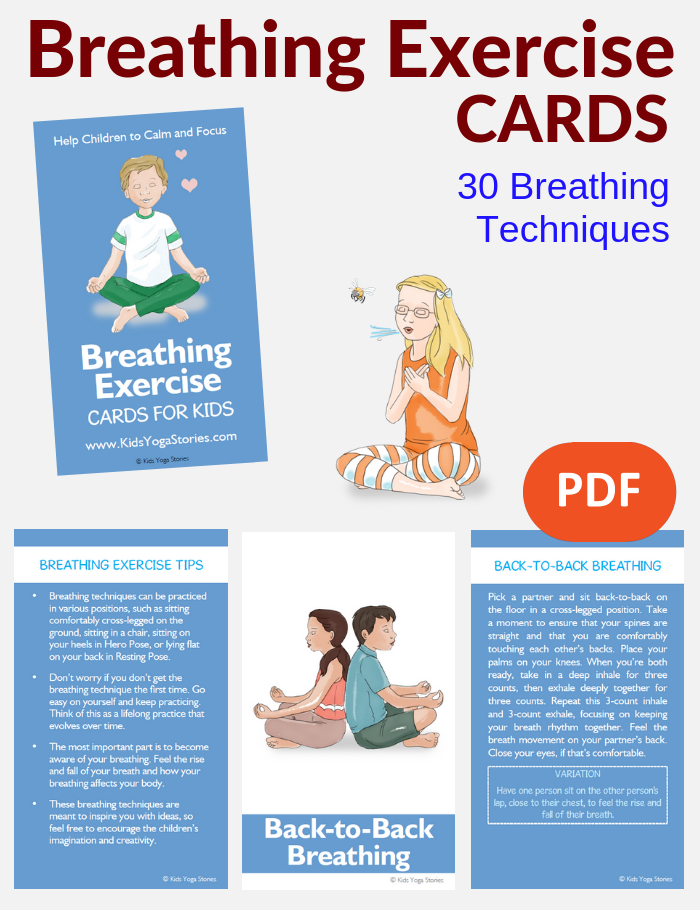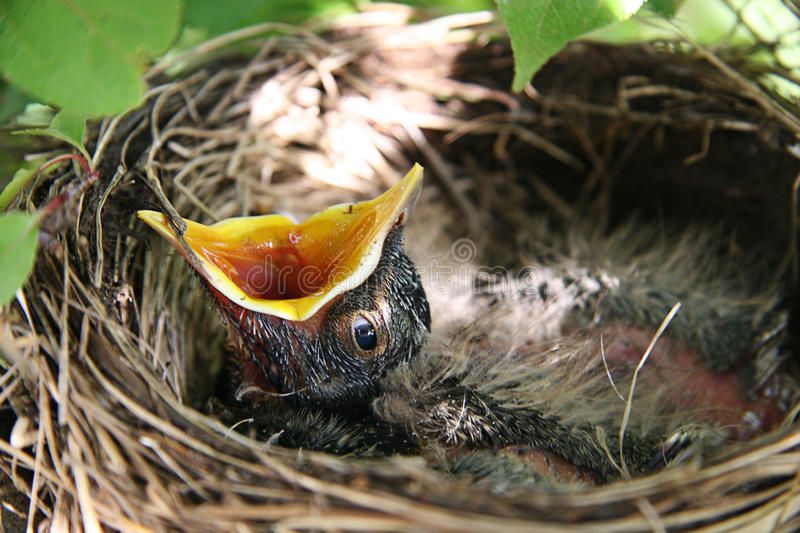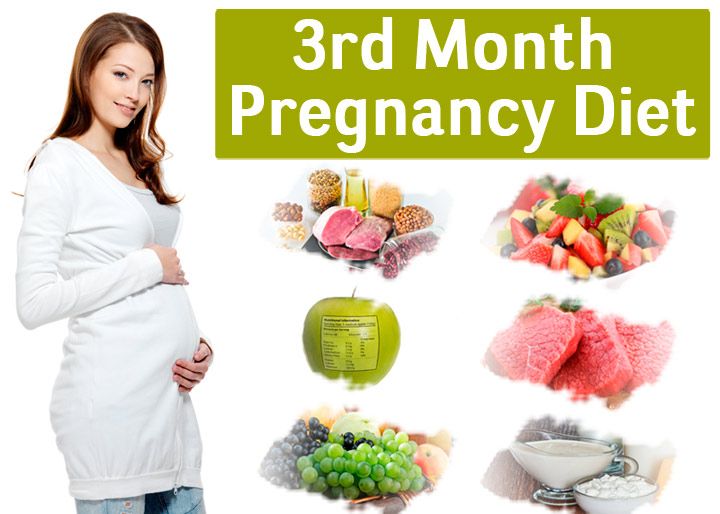Dirty dozen foods for babies
Pesticides in your child's food: What you need to know
Should I be concerned about pesticides in the food my child eats?
Yes. Pesticide residues are often found on produce, and fruits and vegetables are an important part of your child's diet.
Pesticides protect crops from damage, which helps keep groceries affordable. But research shows that pesticides also contribute to a wide range of health problems, including cancer, lung disease, reproductive problems, and possibly disorders of the endocrine and immune systems.
Animal testing indicates that pesticides can cause permanent changes in brain chemistry that may lead to behavioral disorders, learning disabilities, and even long-term damage to the brain and nervous system.
Pesticide exposure can affect your child's health today and in the future. In fact, some effects may not become apparent until later in life.
Do you buy organic food for your family?
Mostly or always
Sometimes
Rarely or never
Are children more vulnerable to pesticides than adults are?
Yes. Children tend to eat a limited number of foods, which can increase their exposure to specific pesticides. They also eat more food relative to their body weight than adults do.
Children may also absorb pesticides more easily. And because their gastrointestinal tract is still developing, their bodies may be less capable of breaking down toxins. Finally, pesticides can block absorption of the nutrients that are vital to healthy growth and development.
Keep in mind that eating food isn't the only way your child can come in contact with pesticides: They can also get into drinking water.
And if you use pesticides in your home or yard, that's another way your child will be exposed. You can even track pesticides into your home on the soles of your shoes. Then your child can ingest the chemicals if he plays on the floor or puts something from the floor into his mouth, for example.
(Pesticides can also cross the placenta, so pregnant women need to take care to minimize exposure.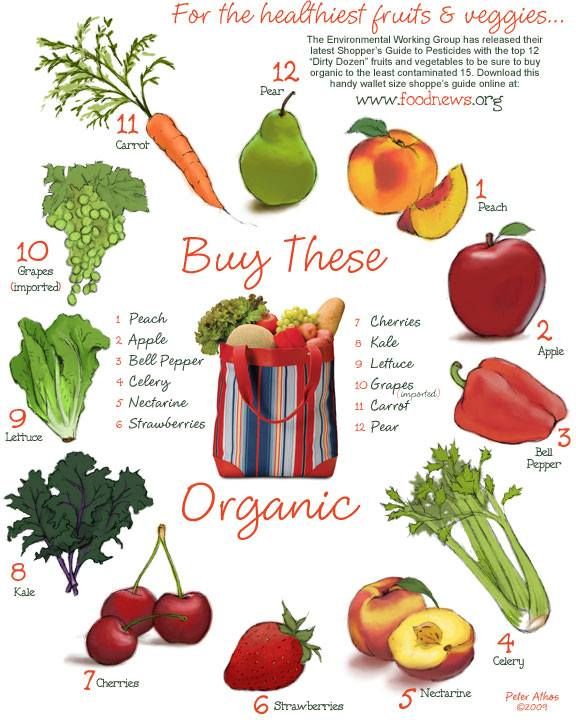 )
)
Advertisement | page continues below
Aren't there regulations to protect my child from pesticides in food?
In the United States, existing regulations are intended to do just that. The Environmental Protection Agency (EPA) sets limits on the amount of pesticides that may be used on crops. The limit is based on how toxic a particular pesticide is, how much residue will remain on the crop, and how much of the crop a consumer is likely to eat.
The Food Quality Protection Act, passed in 1996, requires that the residue levels of pesticides be safe for babies and children, taking into account children's special sensitivity to pesticides. However, under certain circumstances – like in the case of economic hardship to the farmer – the EPA can authorize the use of pesticides that don't meet safety standards.
Some consumer advocacy groups believe that limits on pesticides should be stricter to protect children.
While federal regulations have been gradually prohibiting the most dangerous pesticides, more remain in use. In addition, tests have found that some produce contains high levels of pesticides that have long been banned in the United States because these chemicals are still in the soil. And when farmers plant in contaminated soils, they often end up with contaminated produce.
In addition, tests have found that some produce contains high levels of pesticides that have long been banned in the United States because these chemicals are still in the soil. And when farmers plant in contaminated soils, they often end up with contaminated produce.
The U.S. Department of Agriculture's (USDA) Pesticide Data Program tests foods for pesticide residues. According to the program's annual report, 64 percent of the fruits and vegetables – both fresh and processed (including baby food) – tested in 2010 had detectable pesticide residues. Low levels were found in eggs, oats, catfish, and drinking water.
The USDA emphasizes that these foods are safe to eat. Pesticide residues were largely within the limit deemed acceptable by the EPA.
Why do fresh fruits and vegetables have higher residue levels than canned?
Foods grown for processing don't need to look appealing, so they normally aren't sprayed as much before harvest. And when foods are processed, they're often peeled, washed, or heated, which removes many pesticide residues.
Should I cut down on the amount of fresh fruits and vegetables I feed my toddler?
No. Don't let a fear of pesticides make you serve less produce. Fruits and vegetables are an important part of a healthy diet for every child.
The American Academy of Pediatrics (AAP) points out that the negative impact of not including fruits and vegetables in your child's diet is far greater than any potential risk from pesticides at the levels found in produce. And there are things you can do to reduce the amount of pesticides your child consumes without restricting produce in his diet.
What can I do to protect my child from pesticides in food?
These simple steps can greatly reduce the amount of pesticides in your family's food:
- Peel fruits and vegetables, and remove the outer leaves of vegetables like lettuce and cabbage.
- Scrub (under running water) all fruits and vegetables that you don't peel. Cleaning products specifically designed to wash produce may also help.

- Some foods – like strawberries, grapes, broccoli, lettuce, and spinach – are more difficult to wash. Soak these briefly, then rinse.
- Choose produce without mold, bruising, and decay. These are likely to harbor more pesticides.
- Trim the fat off meat and remove the skin from poultry. Pesticides (and other environmental chemicals) are often concentrated in the fat and skin of poultry, meat, and fish.
- Consider buying organic produce, especially foods your child eats a lot of or items on the "Dirty Dozen" list (below).
- Look for locally grown produce. Fruits and vegetables that are grown far away require after-harvest pesticides and waxes to help them survive the long trip. And produce that has to travel is often picked before ripening, which reduces flavor as well as nutrients.
- Buy produce in season. Although it seems like a treat to buy juicy, red strawberries or tomatoes in the dead of winter, keep in mind that food grown out of season usually comes from another hemisphere.
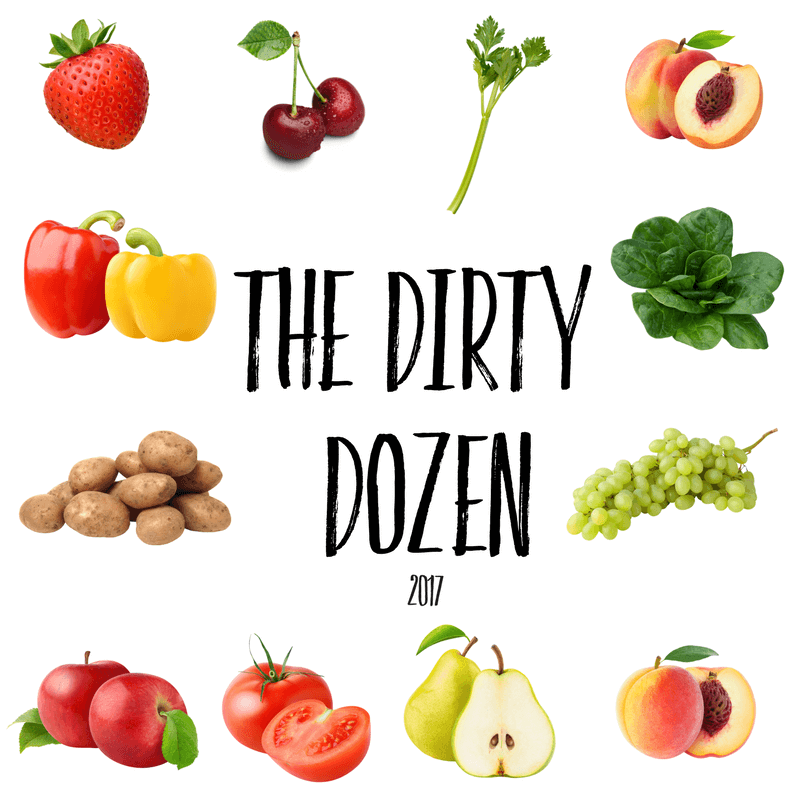 Again, this produce will be picked earlier and probably contain more pesticides.
Again, this produce will be picked earlier and probably contain more pesticides. - Serve a wide variety of food, especially produce. A varied diet limits repeated consumption of the same pesticide.
Avoid the "Dirty Dozen"
When purchasing and preparing produce, keep in mind the Environmental Working Group's "Dirty Dozen". This list of the fruits and vegetables with the highest – and lowest – levels of pesticide residue is based on test results from the United States Department of Agriculture.
As of 2019, these are the 12 fruits and vegetables with the highest levels of pesticide residue: strawberries, spinach, kale, nectarines, apples, grapes, peaches, cherries, pears, tomatoes, celery, and potatoes.
These had the lowest levels of pesticide residue: avocados, sweet corn, pineapples, frozen sweet peas, onions, papayas, eggplants, asparagus, kiwis, cabbages, cauliflower, cantaloupes, broccoli, mushrooms, and honeydew melons.
This doesn't mean that you need to ban apples from your shopping cart, but you may not want to rely on them solely to meet your child's fruit requirements. Introduce your child to many different kinds of fruit, including those with low pesticide residue, like kiwi and papaya. And when you do serve apples that aren't organic, wash them thoroughly or peel them.
Is organic produce worth the additional cost?
That's up to you. Two recent research reviews found no compelling evidence that organic foods were nutritionally better than nonorganic foods. Eating organically grown foods may reduce your exposure to pesticides, but they have the same nutritional value as their conventionally grown counterparts. Also, some organic meat (like pork) doesn't have the antibacterial properties that make it less likely for bacteria to grow.
But a study done in 2008 found that when children switched to a diet of organic food, the amount of pesticides in their urine dropped to nearly undetectable levels.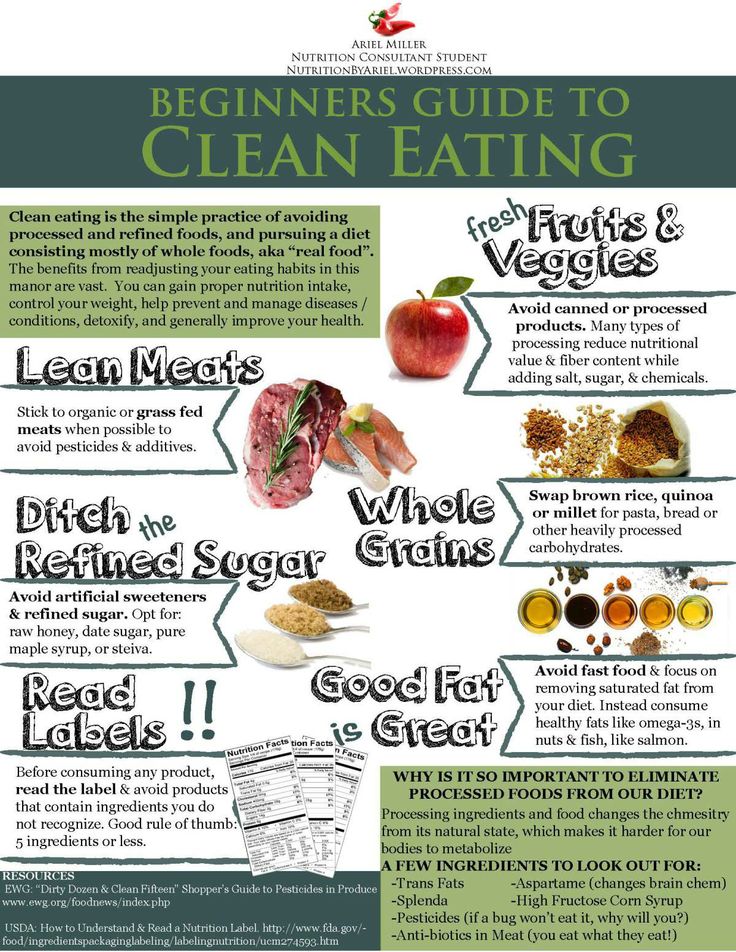 And some studies also show that organic fruits and vegetables actually are more nutritious because they contain more vitamin C and antioxidants, which may help prevent heart disease, than nonorganic fruits and vegetables. For example, one study found that organic strawberries have 8.5 percent more antioxidants than nonorganic fruit.
And some studies also show that organic fruits and vegetables actually are more nutritious because they contain more vitamin C and antioxidants, which may help prevent heart disease, than nonorganic fruits and vegetables. For example, one study found that organic strawberries have 8.5 percent more antioxidants than nonorganic fruit.
If you choose to buy organic produce, try to buy it directly from the producer – there's a good chance it'll be cheaper. Look for organic growers at your local farmer's market, farm stand, or food cooperative.
And if you have the outdoor space, consider growing some of your own organic fruits and vegetables. Gardening is also a great way to teach your child about nutrition.
What are The Dirty Dozen and The Clean Fifteen?
If you have angst over whether to buy organic, I understand: Like you, I’ve stood in the aisles of the grocery store weighing the costs and benefits and trying to figure out the smartest thing to do for my family.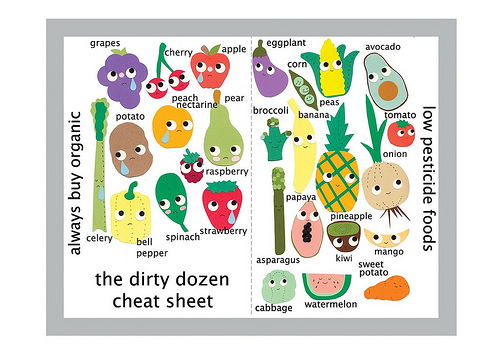 In the end, I decided to be strategic with my organic dollar. That means I pick and choose which foods I buy organic, based on how frequently we eat them—and in the case of fruits and vegetables, how likely they are to be treated with chemical pesticides. One of the tools I use to make those decisions is the Shopper’s Guide to Pesticides in Produce from the Environmental Working Group (EWG), which includes their “Dirty Dozen” and “Clean Fifteen” lists.
In the end, I decided to be strategic with my organic dollar. That means I pick and choose which foods I buy organic, based on how frequently we eat them—and in the case of fruits and vegetables, how likely they are to be treated with chemical pesticides. One of the tools I use to make those decisions is the Shopper’s Guide to Pesticides in Produce from the Environmental Working Group (EWG), which includes their “Dirty Dozen” and “Clean Fifteen” lists.
The lists rank fruits and vegetables based on their pesticide contamination. The goal is to help shoppers prioritize their organic purchases and reduce their exposure to pesticides. Why do chemical pesticides matter? These chemicals are designed to kill insects but may have risks to people too—especially kids, whose smaller body size makes them more vulnerable than adults. Children’s weaker immune systems may also mean they can’t eliminate potential toxins as effectively as grown-ups.
Using results from USDA testing of produce samples, EWG ranks fruits and vegetables in categories of “dirty” (the produce with a higher number of pesticide residues) and “clean” (those with the least). In the USDA tests, the produce was all washed or peeled before testing to mimic how they’re served at home (which indicates that residues may still linger after washing and peeling).
In the USDA tests, the produce was all washed or peeled before testing to mimic how they’re served at home (which indicates that residues may still linger after washing and peeling).
Here are EWG’s rankings:
Dirty Dozen
These foods had multiple pesticide residues and a higher concentration of pesticides than other produce.
- Strawberries
- Spinach
- Kale/Collard/Mustard greens
- Nectarines
- Apples
- Grapes
- Cherries
- Peaches
- Pears
- Bell and hot peppers
- Celery
- Tomatoes
Clean Fifteen
These fruits and vegetables have the fewest pesticide residues and low concentrations of pesticides.
- Avocados
- Sweet corn
- Pineapples
- Onions
- Papayas
- Frozen sweet peas
- Eggplant
- Asparagus
- Broccoli
- Cabbage
- Kiwifruit
- Cauliflower
- Mushrooms
- Honeydew
- Cantaloupe
What about the fruits and veggies in baby food? Baby food tends to have fewer residues that raw fruits and veggies do because it’s cooked, which naturally reduces levels of pesticides.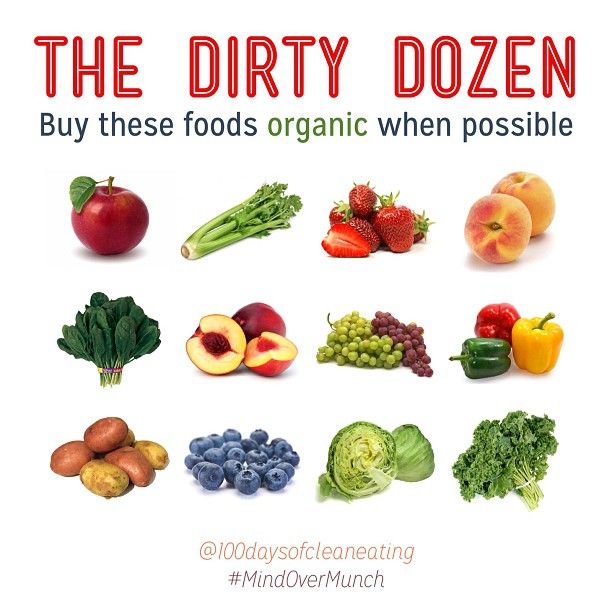 However, some samples of American baby food tested by the USDA (especially applesauce, peaches, and green beans) have been shown to have pesticide levels that exceed the limit set by the European Commission for baby food (the US doesn’t have special limits for baby food). The tests did not reveal significant pesticide residues on baby food carrots or peas.
However, some samples of American baby food tested by the USDA (especially applesauce, peaches, and green beans) have been shown to have pesticide levels that exceed the limit set by the European Commission for baby food (the US doesn’t have special limits for baby food). The tests did not reveal significant pesticide residues on baby food carrots or peas.
Don’t get me wrong: I don’t follow the EWG lists to the letter. There are items on the Dirty Dozen list that I buy conventional because organic versions aren’t available or are out of my budget. But as with all produce, I wash it well (using my hands to rub it vigorously under running water) to remove some of the pesticide residue. I also vary the kinds of fruits and veggies I buy to avoid getting repeated exposure to certain chemicals. Learn more about pesticides and produce.
Most importantly, I always keep in mind that eating fruits and vegetables is the top priority, regardless of whether the produce is organic. As the EWG says in their report: “The health benefits of a diet rich in fruits and vegetables outweigh the risks of pesticide exposure.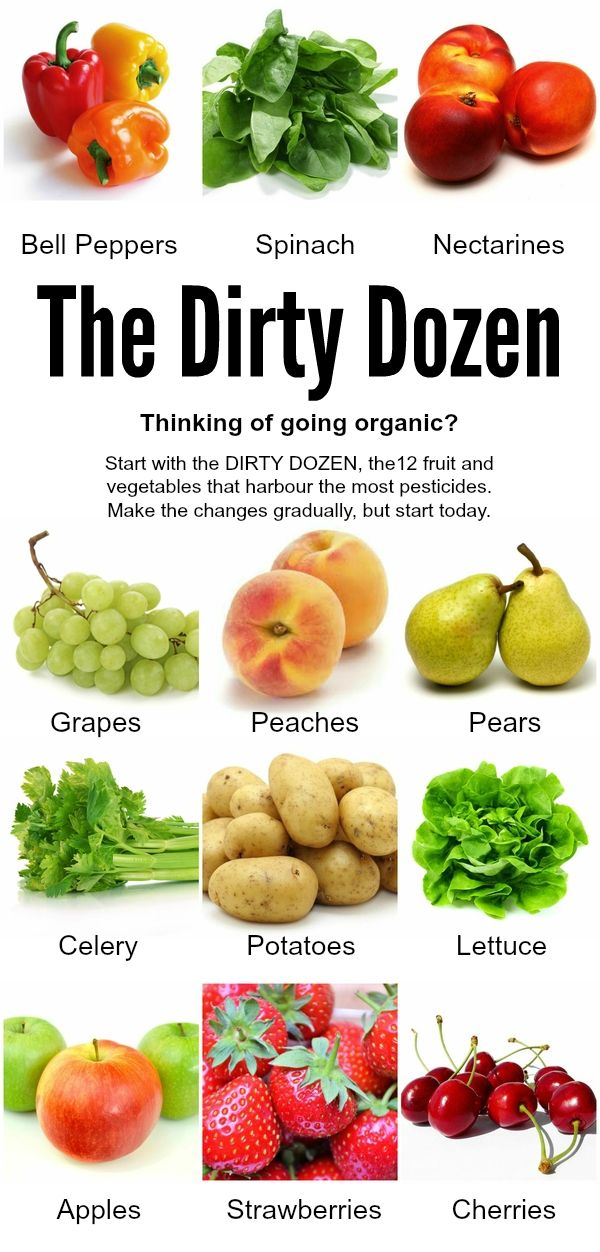 Use EWG’s Shopper’s Guide™ to reduce your exposures as much as possible, but eating conventionally grown produce is better than not eating fruits and vegetables at all.” As a dietitian, I say AMEN to that!
Use EWG’s Shopper’s Guide™ to reduce your exposures as much as possible, but eating conventionally grown produce is better than not eating fruits and vegetables at all.” As a dietitian, I say AMEN to that!
Clean List and Dirty Dozen 2020. What to buy organic?
When to buy organic fruits and vegetables? The EWG has released a new report, The Clean List and the Dirty Dozen, the foods most contaminated with pesticides.
The EWG Environmental Working Group analyzes all USDA data each year to determine which US fruits and vegetables contain the most pesticides and which contain the least.
Called the Clean 15 and Dirty Dozen lists, these lists are not designed to discourage shoppers from avoiding fruits and vegetables, but to help make informed purchasing decisions. nine0003
“Because the Clean List contains few pesticides because of the thick skins of the vegetables or because they are easier to grow, these vegetables can be safely bought in the regular version without risking your health,” says researcher and toxicologist Alexis Tiomkin.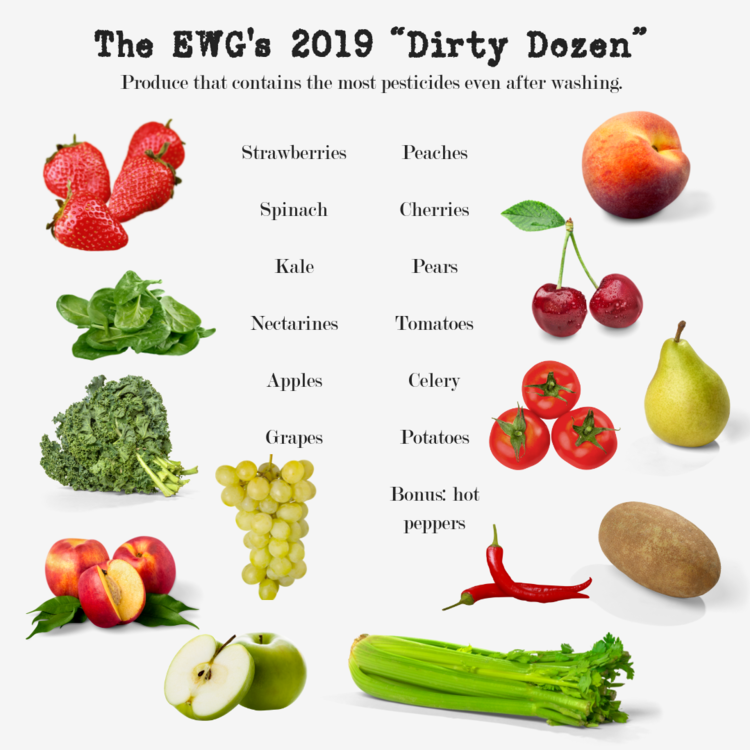 Such lists are useful to people who do not have access or financial means to buy organic food. Knowing these nuances, we ourselves decide what to buy in the organic version, and what to do with the usual one.
Such lists are useful to people who do not have access or financial means to buy organic food. Knowing these nuances, we ourselves decide what to buy in the organic version, and what to do with the usual one.
All vegetables and fruits on the "Clean List" can be bought in regular, they contain the least amount of pesticides or do not contain them at all. nine0003
Clean list 15 (2020)
1. Avocado
2. Sweet corn
3. Pineapple
4. Onion
5. Papaya
6. Sweet peas (frozen)
90 7. Eggplant 8. Cauliflower
10. Cantaloupe melon
11. Broccoli
12. Mushrooms
13. Ordinary cabbage
14. Honey melon
15. Kiwi
Avocado, like last year, again became the “cleanest”, followed by sweet corn . Less than 2% of their samples showed the presence of pesticides. The rest of the vegetables on the list contained few pesticides. According to the report, 70% of fruits and vegetables on this list did not show the presence of chemicals. nine0003
nine0003
In this section you can buy ready -made additive programs
Dirty dozen 12 (2020)
1. Strawberry
2. Spinach
3. Cabbage of Kale
4. Nectarins
5. Apples
6. Grapes
7. Peaches
8. Cherries
9. Pears
10. Tomatoes
11. Celery
12. Potatoes
The list of the most polluted vegetables and fruits has not changed compared to last year. Strawberries again lead in the number and variety of pesticides, followed by spinach. nine0054
What's wrong with pesticides
“Pesticides are used to kill weeds, so they have a toxic effect,” says Alexis Temkin. For example, studies have shown that when you are chronically exposed to low doses of pesticides, it leads to adverse health effects over time.
The EWG writes that "the health benefits of a diet rich in fruits and vegetables outweigh the risks of pesticide exposure." Therefore, it is worth keeping in mind a list of the most pesticide-contaminated vegetables and fruits. But, if you do not have alternative options, then buy products grown in the usual way. nine0003
But, if you do not have alternative options, then buy products grown in the usual way. nine0003
Purchase security
The situation is tense now and this question may arise. How safe is it to buy fruits and vegetables while the coronavirus is spreading? The CDC says "there is currently no evidence of food-borne transmission of COVID-19."
Feel free to buy bright fruits and vegetables, they all strengthen the immune system and compensate for the deficiency of vitamins and flavonoids. Just don't forget to wash your groceries when you get home. This rule works at any time. nine0003
How to slow down aging
Do you want to slow down aging? Sign up for Anti-Age Week 2.0 and let's spend it together. There will be Anti-Age nutrition, menus, research and practice.
Click here to register
The Dirty Dozen: products with the highest and lowest pesticide content (La Vanguardia, Spain)
InoSMI materials contain only estimates of foreign media and do not reflect the position of the editors of InoSMI
Read inosmi.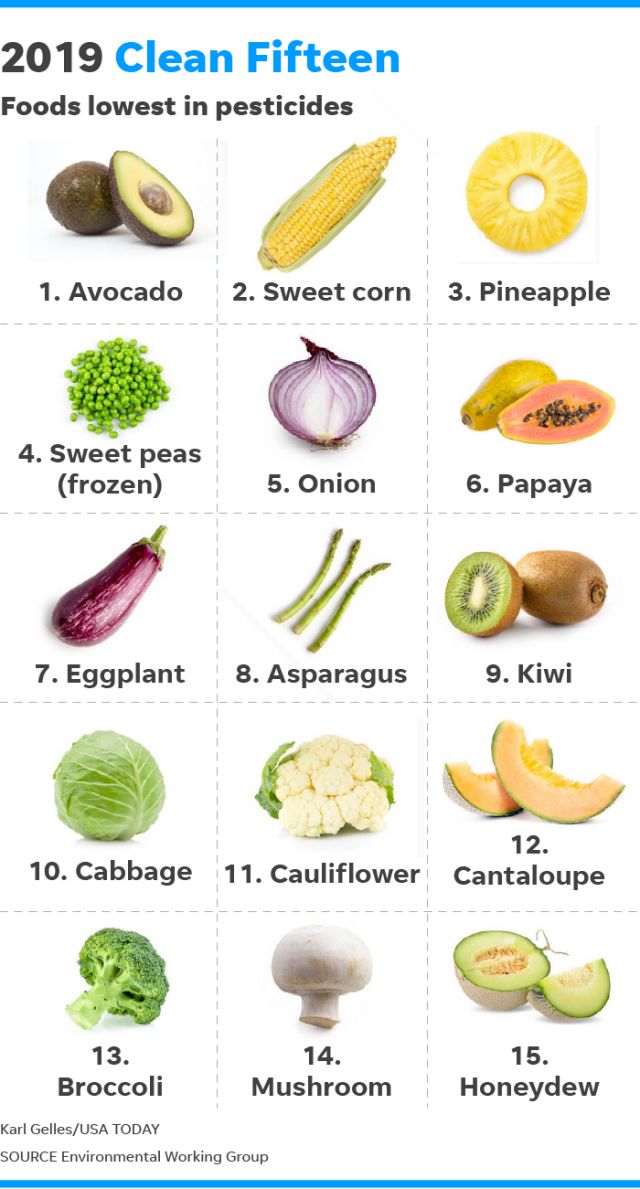 ru in
ru in
Known the benefits of eating vegetables and fruits every day, but modern farming practices force us to approach their choice with an environmental concern. La Vanguardia publishes a list of vegetables and fruits with the highest pesticide content, as well as a list of the safest. nine0003
Brunella Vásquez
The foods listed below are considered delicious and full of health benefits, but they need to be chosen with care as they are part of the new Dirty Dozen list. This is a list of fruits and vegetables with the highest pesticide content, and it is compiled by the American environmental group Environmental Work Group. The list makes you think about habitual farming methods.
Experts say avoiding pesticides is especially important for babies and children, as such substances can harm the developing brain. Along with compiling a food list in 2020, a study was conducted that identified mental retardation in children that could be caused by organophosphates, a common class of pesticides. nine0003
nine0003
Black List
The 2021 pesticide-contaminated fruits and vegetables ranking includes 47 different fruits and vegetables. And it's based on more than 43,000 data sets collected by the USDA and the Food and Drug Administration. According to the Environmental Working Group 2021, strawberries unfortunately continue to be at the top of the Dirty Dozen list of fruits and vegetables containing the most pesticides
In addition, according to a 2017 study by the University of Massachusetts Amherst in the Journal of Agricultural and Food Chemistry, the best method for removing pesticide residue from apples is to use a baking soda solution to wash them. Another more costly option is to opt for organic food.
Dirty Dozen
1. Strawberry
2. Spinach
3. Kale & Mustard
4. Nectarins
5. Apples
6. Grapes
7. Cherry
8. Persian
9. Pear
10. Bulgarian and acute pepper
This does not mean that we should stop buying or consuming these products.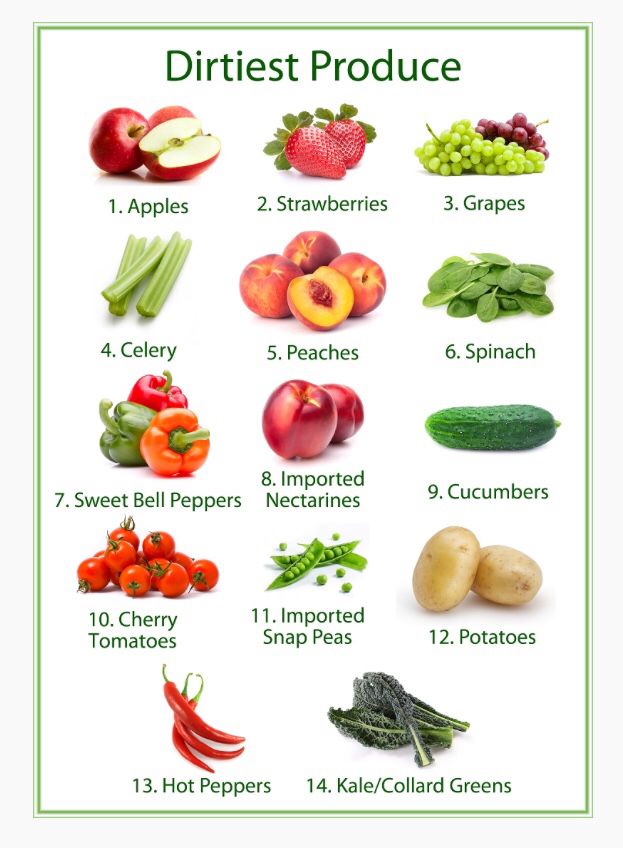 The purpose of this list is to inspire us to make smarter food choices. If the price is affordable, then choosing the organic versions of the vegetables and fruits included in the list should eliminate any potential risks associated with the possible presence of pesticides in them. nine0003
The purpose of this list is to inspire us to make smarter food choices. If the price is affordable, then choosing the organic versions of the vegetables and fruits included in the list should eliminate any potential risks associated with the possible presence of pesticides in them. nine0003
In addition, the European Union Food Safety Agency ensures that the levels of pesticides in these products comply with current legislation, as shown in its latest report, and that the food is therefore safe to eat. Wash fruits and vegetables thoroughly. How? Actively rinsing them under running water rather than in a bowl of water. If the fruits are not soft, it is better to wash them with a brush.
Products with the lowest pesticide content
The report also includes a list of 14 "clean" foods with the lowest pesticide content. Nearly 70% of the fruit and vegetable samples tested were free of pesticide residues, making them the "safest choice".
"Pesticides are extremely rare in these products," says the Environmental Working Group report.